
Eadweard Muybridge was a fundamental pioneer in the history of film and animation. Without him and his ingenious creations, cinema would not be where it is today. He was a successful luxury bookseller, world-renowned photographer, and inventor that people all around the world are still in admiration of today. He was truly an incredible individual.
Early Life
Born in Kingston on the 9th of April 1830, as Edward James Muggeridge. His mum ran a barge business behind their house on the River Thames. As a child, he was always inventing new names for himself, and toys to play with, which marks the very early beginning of his inventiveness.
Near his house, there is a coronation stone with the name “Eadweard Muybridge” carved into it. It is thought that this is where he got the inspiration for the unusual spelling of his name from.

Growing up, Eadweard quickly got bored of the plain little town that Kingston was in those days, and decided that he didn’t want to work in the family barging business, but instead wanted adventure, he wanted to experience everything the world outside of Kingston had to offer. At the age of 20, he set off across the ocean for the exciting land of America. There are no records of the next five years of his life. No one quite knows how he got there, but in 1855 his name was recorded in the place that is now San Fransisco. He had finally made it to America.
Just a few years earlier, San Fransisco had discovered gold, and the fast-growing city was a crazy place, filled with hangings, duels and brothels. It was essentially the wild west. This place where anything was possible vastly contrasted the life he knew in Kingston, and I imagine that it was albeit a hard and tough change, but a refreshing one.
Adulthood
It was here that he established himself as a luxury bookseller, by the name of Edward Muygridge. He also started making engravings and taking photographs of celebrities and famous murder victims. By now he was 30 years old and was vaguely known amongst the general public. He announced in the newspapers that he was leaving his old career behind, in pursuit of a more serious life in photography.
But after he set off once again on a new adventure, he missed his boat, so instead began the long, arduous nine-day journey by stagecoach. One day whilst on the journey, he said that “I recollect having supper at a stagecoach station on the road. We then got on board the stage, which was drawn by six wild mustang horses. That is the last I recall of those nine days.” The stagecoach had a major crash, which resulted in Muybridge sustaining a serious head injury, and a near death experience.

“When I recovered, each eye formed an individual impression, so that looking at you, for instance, I could see another man sitting by your side.” It is thought that although terrible, this could have been a turning point in his life; for a small period of time, he saw the world through a series of different images from each eye, which could have inspired his major future success in photography, which eventually led on to his historic horse invention. It is also common that with frontal lobe injuries that people become more disinhibited, reckless and thrill-seeking, which could have helped him in his future daring photograph opportunities.
Photography
After this, he returned to England for six years. On his return to America, he was a phenomenally good photographer and had changed his name to the name that would be written down in the history books: Eadweard Muybridge. It was at that point that he embarked on his photography career, which would lead to great things.
One of the many extraordinary achievements of Muybridge was that he basically created a very early, primitive type of photoshop. He invented a method of superimposing images onto other images. For instance, when this picture was originally taken, the clouds were not there, and neither were the people on the lighthouse. He had another negative photo that he would then print on to the original picture to give the result below.
 .
.
In the photograph below the superimposed clouds create a much more dramatic and striking image, than if the original clouds were used. This just goes to show how useful this method was.
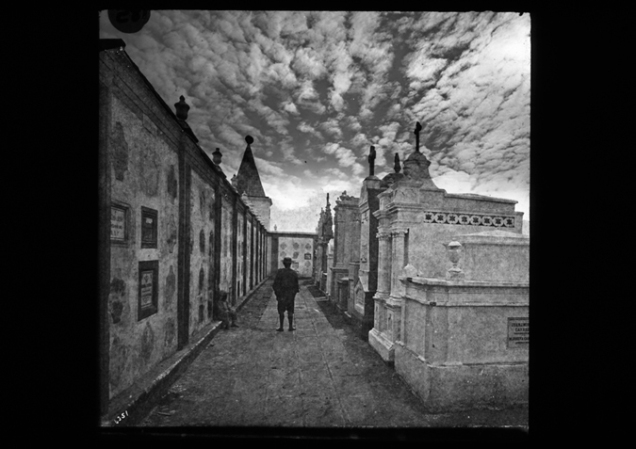
After a while, he adopted the rather grand name; “Helios”, which translates to “the Sun”. By now he had a very large assortment of photography gear, which he named “The Flying Studio”, which was essentially a portable dark room. He would lug this around with him everywhere, which would require pack horses, a couple of assistants, and lots of chemicals. The process of taking these photos was very skilfull and time-consuming. Muybridge even stated that “every photographer is his own chemist.”
Muybridge became well known for his landscape photographs that he took in the Yosemite Valley in California.
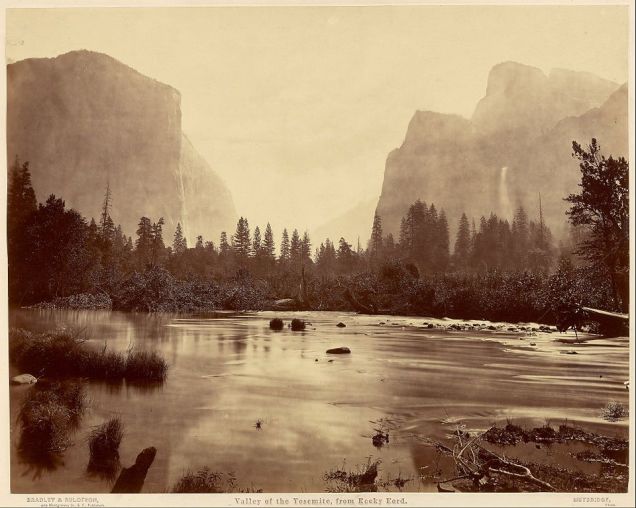
With these photos, he took great inspiration from European photographers and landscape painters. He wanted to capture dramatic images which were ethereal and had elements of a more fantasy based atmosphere.

He sometimes went to extreme and even dangerous efforts, to capture the images that he had his mind set on. He would cut down trees if they interfered with his picture, he would go to places his backpackers outright refused to go, probably like in the picture above. He was even known to lower himself down crevices by ropes. He did all of this just to get the perfect shot.
But all of his efforts paid off, as when he published all 20 of his Yosemite Valley photos in 1868, they were regarded to be the “most exquisite photographic views ever produced on this coast.”
In his photographs, you can see that he obviously not just liked pretty landscapes, but also dark themes, chaos, instability, isolation, loneliness and uncertainty. He often liked to have broken trees and wrecks in his photos.
He knew that these photos of the beautiful wilderness would sell very well back home in America, because most of the wilderness was undiscovered, and regular civilians had never seen views from the photographic perspectives that he provided them with. After these photos were released, it subsequently became popular to go on holiday to these exotic places shown. After this, California became a much more popular place, with the population suddenly increasing, and the city also became connected to the great railway that was being built. California became a much more industrial place. But the change that he helped catalyse wasn’t all good; natives were pushed out and were subsequently replaced by tourists.
This began to show just how much influence Muybridge’s work would go on to have on the world and the general public.
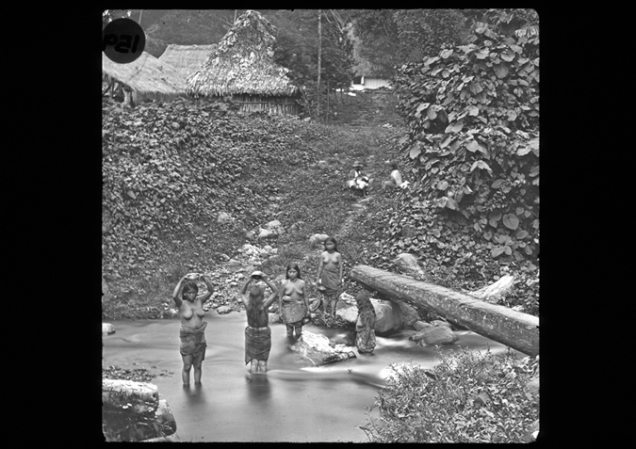
The popular view of the Native Americans at that time was that they were “vermin”, almost inhuman. But he didn’t photograph them like this, he portrayed them as just humans.
The Start of Something Great
During the year around 1870, he met the flirtatious 19-year-old Flora Shallcross Stone who worked in his studio. He fell in love with her but she was already married, so he paid for her divorce, then married her.

In that same year, he met the man that would catalyse his most famous and remarkable work; Leland Stanford. He was most famous for being one of the main Governing forces behind the creation of the railway. He held a great amount of money and power in his chubby little hands.

He loved horse racing, he saw a horse as a machine, not unlike his trains, and wanted to know how it worked. He made a bet of $25,000 that when a horse is running, all four of its hooves lift off the ground at once momentarily. Probably due to Muybridge’s emerging success and evident talent, Leyland chose him to solve the mystery. Leyland let Muybridge use his prized racehorse Occident.
At first, Muybridge thought that it was an impossible feat to prove, as the technology required to stop motion was way beyond the tech of that time. But, being the inventive and creative photographer that he was, he agreed to at least try. Muybridge’s first experiment with Leyland took place on a horse racecourse in Sacramento, California.
He gathered all of the bedsheets that he could find to make a white background, and then covered the ground in a white substance, to make sure that as much light as possible reflected back onto the horse. The first couple of attempts didn’t work, so he had to invent a mechanism that could increase the shutter speed, which would result in a form of stop motion. He succeeded and boastfully announced that with a single photographic negative, he had proved that all four of Occident’s hooves did indeed momentarily lifted off of the ground whilst galloping. But he later admitted that it was shadowy and indistinct. So he went back to experimenting. But all of the exciting innovation was interrupted.
Everything Crumbles
They had a baby, who they named Florado Helios Muybridge. But his home life with his wife, Flora, was starting to unravel. Due to the nature of his work he would often be away from home for weeks, even months at a time. After a particularly long trip, he returned to discover a handful of letters that made it clear that his wife had had an affair with a certain Major Harry Larkyns, who was also probably the dad of little Florado.
Harry Larkyns was a drama critic and Playwright who was well respected among his peers and had served in the army in a couple of wars. Muybridge and Larkyns had had an exchanging of fists, to put it politely, about a year before when Muybridge suspected an intimate connection between Larkyns and Flora, but that evidently didn’t put him off the seductive scent.
A friend of Muybridge’s saw him in the street shortly after learning of his wife’s affair, and said that he was “as white as marble, with his lips compressed.” When he asked him what was wrong, Muybridge replied simply “You’ll find out soon enough.”
Muybridge found out That Larkyns was staying at the Yellow Jacket Mine Inn near Calistoga, and almost immediately began the long journey. Muybridge arrived at 11pm. When Larkyns got to the door, Muybridge was standing outside with a revolver pointed straight at him. He said one single sentence; “there is the answer to the letter you sent my wife.” and shot him once in the heart. He stumbled into the parlour and fell down a corpse.
The Trial
Muybridge stood accused of first-degree murder. Seeing as one of the most famous photographers of that time was on trial for murder, it became a major news story. Claims that Muybridge was mentally insane were made. They claimed that the stagecoach accident that left him with a serious orbitofrontal cortex injury, was at least partly to blame. They used his own photographs against him, saying that only a madman would hang off of cliff edges just to get a photograph.

Muybridge pleaded guilty. But because this land was essentially still being developed, so too was the jurisdictional system. Sexism was a major issue at this point in history, and the jury decided that killing someone for sleeping with your wife was a completely reasonable response. The jury rejected the claims of insanity and found Muybridge not guilty, on the grounds of “justifiable homicide”.
History Being Made
A free man, Muybridge soon returned in full force to his horse experiments and photography. In 1878 he took 13 photographs side by side and produced a 7 metre-long photograph which showed a 360 degree, panoramic view of San Fransisco.

Later that year, he wanted to properly prove his horse hypothesis. So on a horse racecourse, he set up a long line of cameras that were each triggered by a separate taught piece of string that was stretched out over the race track horizontally. When the horse ran, it triggered the string, which in turn made its corresponding camera take a picture. Each camera was able to take photographs with a shutter speed of one-thousandth of a second. When all of the photos were put together in a series, these images showed how the horse moved. For the first time in history, human beings had stopped time.

The photos proved in tantalising detail that all four of a horse’s hooves do indeed lift off of the ground at once. But these movements portrayed by the images looked so strange to the general public, that they originally thought that they were faked. Some of the popular cartoonists produced drawings that made fun of the pictures and showed just how unrealistic Muybridge’s pictures looked to them. This cartoon was made by Henry Stull in 1883.

Muybridge set out to prove them wrong. He invented the Zoopraxiscope, which was a hand crank-operated, moving picture projector.

He hired artists to painstakingly paint each picture of the horse onto a 16″ glass disk, which he would then put into the Zoopraxiscope. The horses had to be painted vertically elongated, to compensate for the distortion caused by the projection. The result was the first ever moving picture projection. The Zoopraxiscope paved the way for every film, ever made, ever; and the likes of Thomas Edison.

The Homestretch of His Career
After the success of his running horse, Muybridge was sponsored by the University of Pennsylvania to continue his motion studies. He took thousands of photographs of animals and people. These studies greatly influenced the world and society. Muybridge’s influence can be seen in many artists’ works. For instance, his work had a great effect on the way that Francis Bacon portrayed human movement. This Francis Bacon painting clearly shows just how greatly he was influenced by Muybridge.
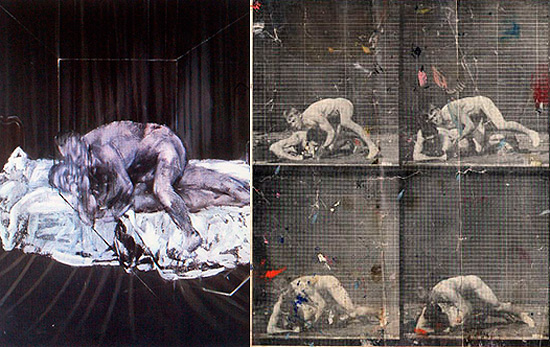
But Muybridge’s influence on the world wasn’t all good. The photos that he took of women showed them doing what was considered to be womanly activities at the time, like carrying buckets of water, playing with children, doing house chores etc. Some photos also how women in sexualised poses. It is thought that these photos could have helped to enforce female stereotypes, which had a detrimental effect on the lives and power of women in those days. They were also mostly photographed nude, or with very thin and loose clothing, which suggests that they were also made partly for titillation, and might not have been for 100% scientific purposes. Although most of the men are nude as well, I still think that this is a point worth mentioning.


The portrayal of men in these series of photos showed them doing very “manly” activities, like horse riding, hammering, boxing etc, and always looking very strong and powerful. There are also a lot of photos of men doing lots of sports. At this time in history, Universities were known for the majority of their students not getting out much, so therefore being pretty out of shape. Since these series of photographs were commissioned by the University of Pennsylvania, they probably told Muybridge to portray muscled, healthy men doing physically exerting activities – in an effort to change the public’s view of Universities and their students.


The difference in activities being performed by each gender shows generally how society at that time thought about the difference between women and men. Men were shown to be very strong an athletic, doing powerful activities. Whereas women were shown to be less strong, doing maternal and household activities.
Interestingly, his only non-white subject was Ben Bailey, who was a mixed race man. Sadly, enhanced musculature on black men can be understood to have helped reinforce negative racial stereotypes such as aggressive primitivism.
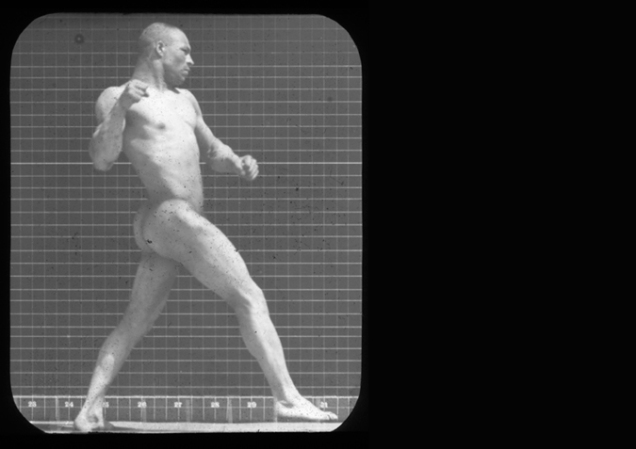
Muybridge also photographed a handful of disabled people. In his book Animal Locomotion, He organised each category of photographic subjects into distinct chapters; the hierarchy seemed to signify the importance of each category to Muybridge. It is interesting that he positioned the chapter about disabled people below the healthy and able-bodied people, and just above the animals. It is almost as if Muybridge as society at that time saw them as less human or valuable then regular people.
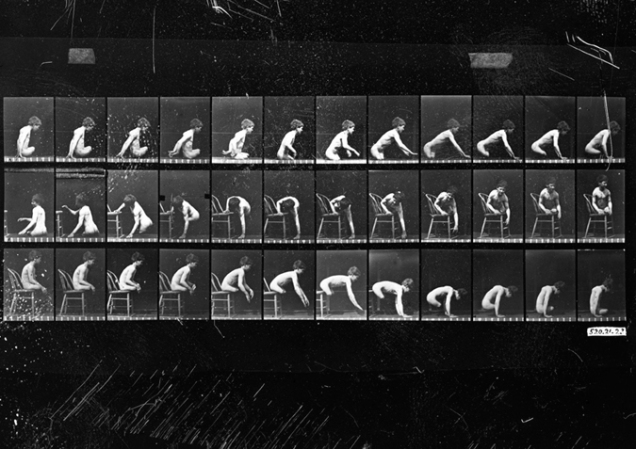
Muybridge himself was also photographed doing a couple of activities. One was flailing a pickaxe around.

As well as all of this, Muybridge gave many lectures at prestigious institutions, and in front of royalty, artists, scientists and the general public. He also published books. The most famous of these are; Animals in Motion (1899) and The Human Figure in Motion (1901).
The Death of a Legend
He left his entire personal collection of his work to the Kingston Museum in London. Rather poetically, he died in the place of his birth and childhood; Kingston upon Thames in 1904. He left a nobody, and he returned a world-famous celebrity, scientist, murderer and artist who had made history.
Research
Motion Studies by Rebecca Solnit (2003).
Animals in Motion by Eadweard Muybridge (1957).
Kingston Museum.
The Eadweard Muybridge leaflet from Kingston Museum.
https://en.wikipedia.org/wiki/Leland_Stanford
https://en.wikipedia.org/wiki/Eadweard_Muybridge
https://cdnc.ucr.edu/cgi-bin/cdnc?a=d&d=RRF18741022.2.19&e=——-en–20–1–txt-
https://cdnc.ucr.edu/cgi-bin/cdnc?a=d&d=LAH18741022.2.15&e=——-en–20–1–txt-txIN——–1txIN——–1
Eadweard Muybridge: moving picture-maker and murderer – or not…..
http://www.nineteenthcenturydisability.org/items/show/19